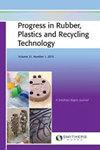Temperature glass and conductivity behavior of epoxy deproteinized natural rubber in ternary blend of EDPNR/PMMA/LiCF3SO3
IF 1.6
4区 材料科学
Q4 MATERIALS SCIENCE, COMPOSITES
Progress in Rubber Plastics and Recycling Technology
Pub Date : 2021-09-06
DOI:10.1177/14777606211042030
引用次数: 0
Abstract
The temperature glass behavior of epoxy deproteinized natural rubber/polymethylmethacrylate/lithium trifluoromethanesulfonate (EDPNR/PMMA/LiCF3SO3) and the conductivity behavior of EDPNR in the ternary blends were studied by DSC and multichannel potentiostat. The DSC result revealed the temperature glass of the EDPNR was shifted to the right with the increase of lithium salt amount in these binary blends composition. However, in the ternary blends of EDPNR/PMMA/LiCF3SO3 the temperature glass revealed the miscibility of these ternary blends. Two different temperature glass values were obtained when the ratio of EDPNR in EDPNR/PMMA was less than 80 wt.%. The ionic conductivity of EDPNR could be improved by increasing the amount of lithium salt up to 35 wt.%, after this amount the ionic conductivity of EDPNR was significantly decreased. While in the ternary blends, the highest ionic conductivity value was found at the ratio 80/20 of EDPNR/PMMA. Furthermore, the factors influencing the temperature glass and conductivity behavior of EDPNR were systematically studied in this work. The results demonstrated an intimate correlation between temperature glass and conductivity behavior of EDPNR.环氧脱蛋白天然橡胶在EDPNR/PMMA/LiCF3SO3三元共混体系中的温度、玻璃化和电导率行为
采用DSC和多通道恒电位器研究了环氧脱蛋白天然橡胶/聚甲基丙烯酸甲酯/三氟甲烷磺酸锂(EDPNR/PMMA/LiCF3SO3)三元共混物的温度玻璃化行为和EDPNR在三元共混物中的电导率行为。DSC结果表明,随着二元共混物中锂盐含量的增加,EDPNR的温度玻璃向右偏移。然而,在EDPNR/PMMA/LiCF3SO3的三元共混体系中,温度玻璃显示了这些三元共混体系的混相性。当EDPNR/PMMA中EDPNR的比例小于80wt .%时,得到了两种不同的温度玻璃值。将锂盐加入量增加到35 wt.%, EDPNR的离子电导率可以得到提高,超过35 wt.%后,EDPNR的离子电导率明显降低。在三元共混体系中,EDPNR与PMMA的比例为80/20时,离子电导率最高。此外,本文还系统地研究了影响EDPNR的温度、玻璃化和电导率行为的因素。结果表明,温度玻璃与EDPNR的电导率行为密切相关。
本文章由计算机程序翻译,如有差异,请以英文原文为准。
求助全文
约1分钟内获得全文
求助全文
来源期刊

Progress in Rubber Plastics and Recycling Technology
MATERIALS SCIENCE, COMPOSITES-POLYMER SCIENCE
CiteScore
4.40
自引率
7.70%
发文量
18
审稿时长
>12 weeks
期刊介绍:
The journal aims to bridge the gap between research and development and the practical and commercial applications of polymers in a wide range of uses. Current developments and likely future trends are reviewed across key areas of the polymer industry, together with existing and potential opportunities for the innovative use of plastic and rubber products.
 求助内容:
求助内容: 应助结果提醒方式:
应助结果提醒方式:


